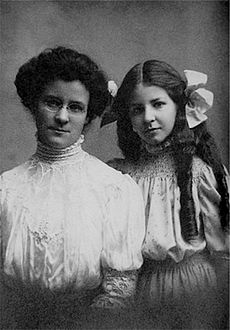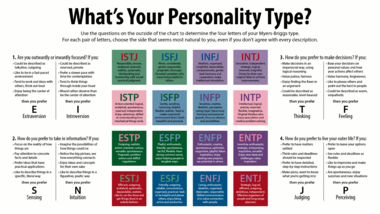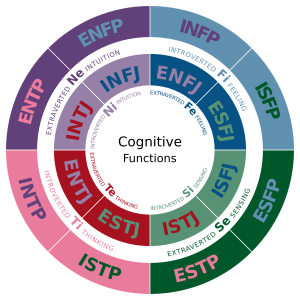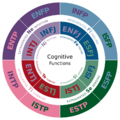Myers–Briggs Type Indicator facts for kids
The Myers–Briggs Type Indicator (MBTI) is a special questionnaire that helps people understand their own psychological preferences. It shows how different people see the world and make choices. Even though many people like it, some scientists think it's not a true science.
The MBTI tries to sort people into one of two choices for four different areas:
- Are you more of an introvert or an extravert?
- Do you prefer using your senses or your intuition?
- Do you make decisions based on thinking or feeling?
- Do you prefer to be judging (decisive) or perceiving (flexible)?
One letter from each area is chosen to create a four-letter result, like "ISTJ" or "ENFP".
Two American women, Katharine Cook Briggs and her daughter Isabel Briggs Myers, created the MBTI. They were inspired by a book called Psychological Types by a Swiss psychiatrist named Carl Jung. Isabel Myers found Jung's ideas about introversion very interesting. She thought his book was too hard for most people to understand, so she tried to make his ideas simpler and easier to use.
Most of the research that supports the MBTI comes from an organization connected to the Myers–Briggs Foundation. This makes some people wonder if the research is truly unbiased. While the MBTI shares some ideas with real psychology theories, many scientists don't fully support it. They point out that it has some scientific weaknesses. For example, they say it doesn't always give the same results, and it might not truly measure what it claims to.
Contents
History of the MBTI

Katharine Briggs started studying personality in 1917. She noticed big differences between her future son-in-law and her own family members. This led her to read many biographies and create her own ideas about four types of people: meditative (thoughtful), spontaneous, executive, and social.
In 1923, Carl Jung's book Psychological Types was translated into English. Briggs realized that Jung's ideas were similar to hers, but much deeper. She later connected her four types to Jung's ideas. Briggs and her daughter Isabel wanted to use these ideas to help people in real life.
Neither Myers nor Briggs had formal training in psychology. They taught themselves about psychometric testing, which is about measuring mental skills and traits. Myers learned how to create, score, and check tests from Edward N. Hay, who worked at a bank.
Briggs and Myers began developing the MBTI during World War II (1939–1945). They believed that if women knew their personality preferences, it would help them find the best war-time jobs. The first version of their guide was published in 1944. Later, in 1956, it was renamed the "Myers–Briggs Type Indicator."
Over the years, the MBTI gained more support from different universities and organizations. In 1975, a company called Consulting Psychologists Press took over publishing the MBTI. After Myers passed away in 1980, the MBTI manual was updated several times.
How the MBTI Works
The MBTI is based on Carl Jung's ideas from 1921. Jung thought that people use four main ways to experience the world: sensation, intuition, feeling, and thinking. He believed one of these ways was usually strongest for a person. The MBTI uses four pairs of choices, called "dichotomies":
- Introversion (I) or Extraversion (E)
- Sensing (S) or Intuition (N)
- Thinking (T) or Feeling (F)
- Judging (J) or Perceiving (P)
The MBTI says that each person has one preferred choice from each pair. This creates 16 possible personality types. The MBTI highlights that these differences are natural and valuable. It suggests that our preferences shape our interests, needs, and what motivates us.
Jung's Ideas vs. MBTI
Jung saw personality types as tendencies, not strict categories. He believed that both introversion and extraversion are natural parts of everyone, and they can balance each other.
Jung's theory included four main functions (thinking, feeling, sensation, and intuition). Each could be used in an extraverted or introverted way. The MBTI uses these eight ideas, but with some changes. Myers and Briggs added the "Judging" or "Perceiving" letter (J or P) to show how a person prefers to deal with the outside world.
Jung also thought that if your main function was introverted, your other functions would be extraverted, and vice versa. Some MBTI experts question this idea, saying there isn't much proof for it.
Type Dynamics and Development
The MBTI suggests that people are born with, or develop, certain preferred ways of seeing and deciding things. It sorts these differences into four pairs of opposites, leading to 16 possible types. No type is seen as "better" or "worse." Just like writing with your left hand is hard if you're right-handed, using your opposite preferences can be difficult. But with practice, you can get better at them.
The 16 types are usually known by a four-letter abbreviation. For example:
- ENTJ: Extraversion (E), Intuition (N), Thinking (T), Judgment (J)
- ISFP: Introversion (I), Sensing (S), Feeling (F), Perception (P)
The idea of "type dynamics" looks at how two, three, or all four preferences work together. Myers and Briggs believed that for each of the 16 types, one function is the most dominant and shows up earliest in life. A second, auxiliary function usually becomes clear in teenage years and helps balance the dominant one. Later in life, a third, tertiary function develops. The fourth, inferior function remains the least developed and often shows up when someone is under a lot of stress.
However, some researchers disagree with the idea of type dynamics. They say it doesn't always match how people actually behave.
The Four Dichotomies
The MBTI uses four pairs of preferences, or "dichotomies." The words used for each pair have special meanings in the MBTI that are different from how we use them every day. For example, someone who prefers "judgment" isn't necessarily "judgmental." The MBTI just shows a preference, not how good you are at something.
Isabel Myers thought that the direction of your preference (like E vs. I) was more important than how strong that preference was.
Extraversion/Introversion
In MBTI, extraversion means turning your energy outward, and introversion means turning it inward. These are different from how we usually use these words.
- People who prefer extraversion get energy from doing things. They tend to act first, then think, then act more. To get their energy back, they need breaks from quiet reflection.
- People who prefer introversion use energy when they act. They prefer to think first, then act, then think again. To get their energy back, they need quiet time alone.
Extraverts focus on people and things outside themselves. Introverts focus on ideas and thoughts inside themselves.
- Extraverts like action; introverts like thinking.
- Extraverts seek broad knowledge; introverts seek deep knowledge.
- Extraverts often like frequent interaction; introverts prefer deeper interaction.
- Extraverts recharge by being with people; introverts recharge by being alone.
Sensing/Intuition and Thinking/Feeling
Jung identified two pairs of functions:
- Perceiving functions: Sensing and Intuition (how you gather information)
- Judging functions: Thinking and Feeling (how you make decisions)
Everyone uses all four functions, but one is usually stronger. Each function can be used in an extraverted or introverted way.
- Sensing (S)** and **Intuition (N) are about how you take in information.
* People who prefer sensing trust information that is real, touchable, and concrete. They like details and facts. They might not trust hunches. * People who prefer intuition trust information that is less about the senses. They look for connections, patterns, and future possibilities. They are interested in the bigger picture.
- Thinking (T)** and **Feeling (F) are about how you make decisions.
* People who prefer thinking make decisions based on what seems logical, fair, and consistent with rules. They are concerned with the truth and might give direct feedback. * People who prefer feeling make decisions by thinking about how it affects people and trying to create harmony. They consider the needs of everyone involved.
It's important to remember that people who prefer thinking don't necessarily "think better" than those who prefer feeling. Both are seen as smart ways to make decisions.
Dominant Function
Jung believed that people use all four functions, but one is used most often and confidently. This "dominant" function is supported by a "secondary" (auxiliary) function. The fourth and least used function is always the opposite of the dominant one. Myers called this the "shadow" function.
Judging/Perception
Myers and Briggs added the idea that people also prefer to show either their "judging" function (thinking or feeling) or their "perceiving" function (sensing or intuition) to the outside world.
- Judging (J) types like to have things settled and decided. They tend to appear logical (if they prefer thinking) or empathetic (if they prefer feeling).
- Perceiving (P) types prefer to keep their options open. They tend to appear concrete (if they prefer sensing) or abstract (if they prefer intuition).
For extraverts, the J or P letter shows their dominant function. For introverts, the J or P letter shows their auxiliary function.
Criticism of the MBTI
Even though the MBTI is popular, many scientists see it as a pseudoscience, meaning it's not based on strong scientific evidence. Some media reports have even called it "meaningless" or "one of the worst personality tests."
Many studies that support the MBTI come from organizations that profit from it. This makes some people question if these studies are truly fair. A review in 1996 found that efforts to link MBTI types to success in jobs were not very clear.
The MBTI has been compared to horoscopes. This is because it can use general descriptions that seem to fit almost anyone, making people feel like the description is specially for them. This is called the Barnum effect.
Not Enough Evidence for Clear Types
The MBTI suggests that people clearly fall into one type or another (like being either an extravert or an introvert). However, most studies show that people's scores on the MBTI scales are more like a smooth range, with most people falling somewhere in the middle, not at the extreme ends. This means that most people are not clearly one type or the other, but a mix.
Validity and Usefulness
In 1991, a group of scientists looked at research on the MBTI. They found that only the Extraversion-Introversion scale showed strong links to other similar tests. The other scales (Sensing-Intuition and Thinking-Feeling) were not as strong. The committee concluded that there wasn't enough good research to say the MBTI should be used for career counseling. They were concerned that the MBTI was so popular without strong scientific proof.
The MBTI is meant to show preferences, not abilities. Its creators say it should not be used to predict how well someone will do at a job. Some argue that the MBTI remains popular because it's easy to understand and many people are trained to use it.
Lack of Objectivity
The MBTI relies on people being honest about themselves. Unlike some other personality tests, the MBTI doesn't check if someone is trying to make themselves look better. So, if someone wants to, they can fake their answers. However, the MBTI's rules say it's wrong to require job applicants to take the test if the results will be used to reject them. The MBTI is meant to help people understand themselves, not to judge them.
Terminology and Descriptions
Some critics say that the words used in the MBTI are too "vague and general." This means that any behavior could fit any personality type, which again points to the Barnum effect. However, others argue that the MBTI descriptions are actually quite clear and unique. Some writers, like David Keirsey, have even added more details to the MBTI descriptions.
Reliability Issues
The MBTI's "test-retest reliability" tends to be low. This means that if you take the test again after a short time, you might get a different result. Studies have shown that between 39% and 76% of people get a different type classification when they retake the test after only five weeks. One article in Fortune Magazine stated that there's about a 50% chance you'll get a different personality category if you retake the test after just five weeks.
This happens because the MBTI uses a dividing line in the middle of each scale. So, two people whose scores are very close but on opposite sides of that line will be put into different categories, even if they are very similar.
Some people argue that the MBTI can be a reliable measure of personality, and that its results depend on the people taking the test and the conditions.
MBTI Statistics
A study in 1973 found that the INFP type was very common among university students studying fine arts and art education. Another study in 1973 found that Intuitive-Perceptive types (ENFP, INFP, ENTP, INTP) were more common among teachers of subjects like English, social studies, and art, compared to science and math teachers.
Usefulness of the MBTI
Isabel Myers believed that the number of different personality types would vary depending on a person's job or field of study. However, some researchers have found that the number of MBTI types in different jobs is actually similar to the general population. Some also worry about using the MBTI to label people or for job satisfaction.
The Myers–Briggs Company, which publishes the MBTI, says it's "the world's most widely used personality assessment." They claim that as many as two million tests are given each year. They and other supporters say the MBTI is as reliable as other psychological tools.
However, as mentioned, some studies say the MBTI "lacks convincing validity data" and is a pseudoscience.
Connections to Other Tests
Keirsey Temperaments
David Keirsey created the Keirsey Temperament Sorter after learning about the MBTI. He linked his four "temperaments" (SP, SJ, NF, and NT) to the MBTI groupings. He also gave each of the 16 MBTI types a name, like "Inspector" or "Healer."
|
ISITEJ
Inspector |
ISIFEJ
Protector |
INIFEJ
Counselor |
INITEJ
Mastermind |
|
ISETIP
Crafter |
ISEFIP
Composer |
INEFIP
Healer |
INETIP
Architect |
|
ESETIP
Promoter |
ESEFIP
Performer |
ENEFIP
Champion |
ENETIP
Inventor |
|
ESITEJ
Supervisor |
ESIFEJ
Provider |
ENIFEJ
Teacher |
ENITEJ
Fieldmarshal |
Big Five Personality Traits
The Big Five personality traits is another popular model that describes personality using five main areas: extraversion, openness, agreeableness, conscientiousness, and neuroticism (emotional stability). Studies have shown that the four MBTI scales are related to four of these Big Five traits. For example, the MBTI's Extraversion-Introversion scale is linked to the Big Five's extraversion.
| Extraversion | Openness | Agreeableness | Conscientiousness | Neuroticism | |
|---|---|---|---|---|---|
| E–I | −0.74 | 0.03 | −0.03 | 0.08 | 0.16 |
| S–N | 0.10 | 0.72 | 0.04 | −0.15 | −0.06 |
| T–F | 0.19 | 0.02 | 0.44 | −0.15 | 0.06 |
| J–P | 0.15 | 0.30 | −0.06 | −0.49 | 0.11 |
The closer the number is to 1.0 or −1.0, the higher the degree of correlation.
These findings suggest that the MBTI measures parts of these larger personality areas. However, they also show that the MBTI doesn't truly measure clear-cut types, but rather four separate dimensions. The MBTI also doesn't have a direct measure for emotional stability, which is part of the Big Five.
Images for kids
- Criticism
- Labeling theory
- Cold reading
- Others
- Adjective Check List (ACL)
- Brain types
- DISC assessment
- Riso–Hudson Enneagram Type Indicator
- FIRO-B
- Forte Communication Style Profile
- Holland Codes
- Humorism
- Industrial and organizational psychology § Historical_overview
- Interpersonal compatibility
- Jungian Type Index
- List of tests § Personality tests
- Organizational culture § Kim Cameron and Robert Quinn
- Personality Assessment System
- Personality clash
- Personality psychology
- Revised NEO Personality Inventory
- Roger Birkman § The Birkman Method
- Socionics, a partner theory
- Strong Interest Inventory
- Minnesota Multiphasic Personality Inventory
- Thomas Kilmann Conflict Mode Instrument
- Personality psychology § Type theories
- Two-factor models of personality § Factors integrated into modern instruments (CPI 260)
See also
 In Spanish: Indicador Myers-Briggs para niños
In Spanish: Indicador Myers-Briggs para niños




